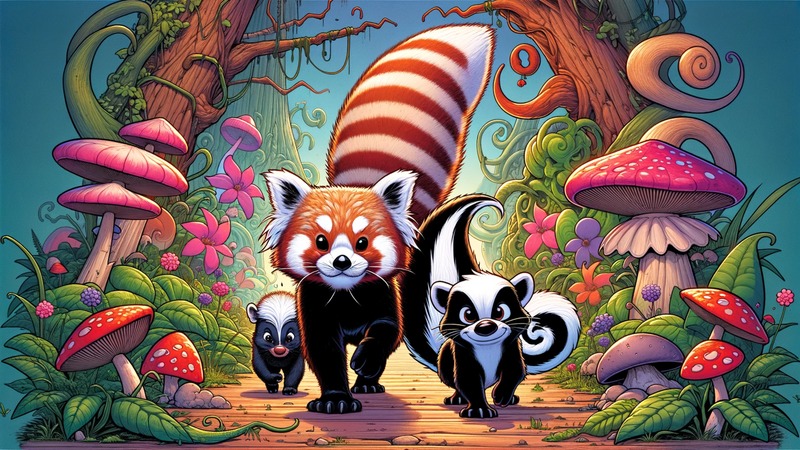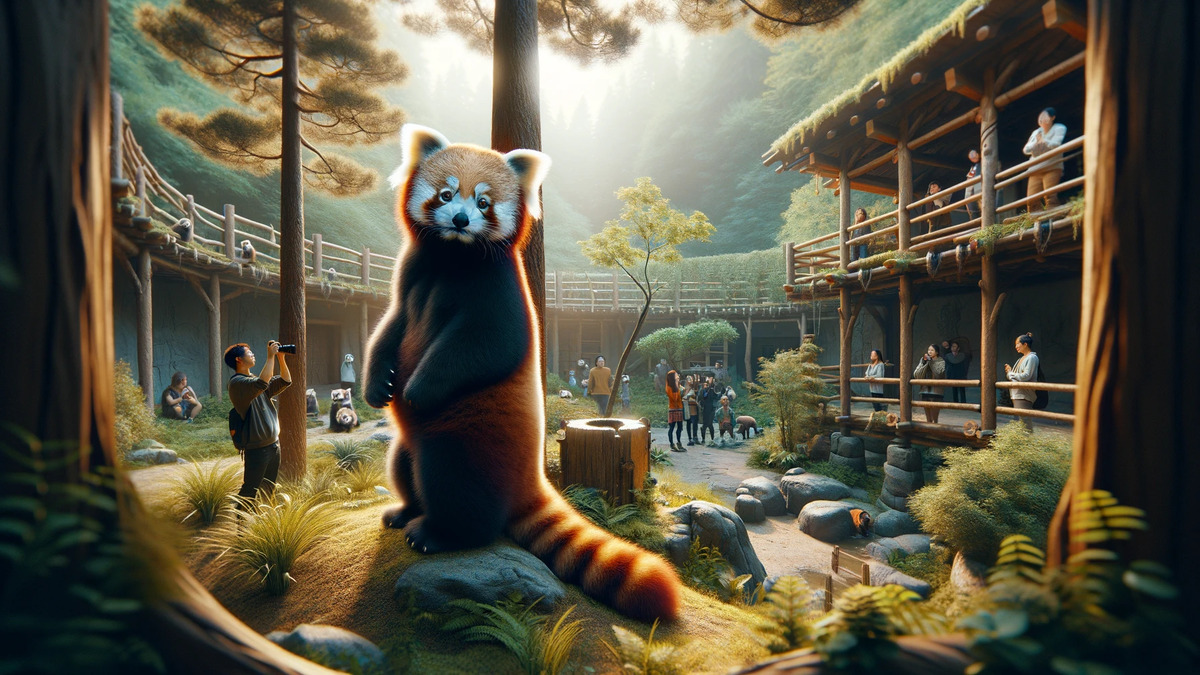The lesser panda is not a panda, but a panda
The lesser panda is not a panda.
However, the red panda was a panda.
You may wonder what this means. But these two statements are true.
It was the red panda that Europeans first called the panda. Then came the giant panda, which is now called the panda, and it monopolised the name panda.
It is also commonly called a lesser panda or, in English, a red panda, but this is the original “panda”.
It would make sense for pandas to always be called giant pandas, bigger pandas or monochrome pandas, but it is too late now. Incidentally, they have a few things in common, but they are also genetically very different species. It seems to be said that you can tell by looking at them.

Why are lesser pandas red?
The red fur of the red panda serves as camouflage in its natural habitat. It helps them blend into the canopy of fir trees, whose branches are covered with reddish-brown mosses and lichens.
The red colour of their fur is related to a type of pigment known as melanin. In mammals, the colouration of their fur is mainly determined by the distribution and type of melanin. Pheomelanin contributes to the red and yellow tones, while eumelanin contributes to the dark brown and black tones. In the case of the red panda, the presence of pheomelanin gives it its characteristic red colour.
Why red pandas wiggle their butts Cute? Really?
Why do red pandas rub their butts?
I have heard myself many times saying how cute they are when I see them at the zoo. (It’s true, I’ve heard it three times.)
Lesser pandas have scent glands on their buttocks, near the base of their tail. These are the so-called smell glands. The red panda rubs this area against trees and rocks to mark its territory by smell.
Some red pandas use it for a different purpose, but they spray it powerfully from here. Skunks.
The difference is whether they release it into the air or rub it against a tree.
This behaviour has several purposes, including communicating their presence to other red pandas, marking territorial boundaries and indicating breeding status. As red pandas are solitary and live in dense habitats, odour marking plays a very important role in red panda communication.
But even if you know they are rubbing their scent glands, they are still cute when you actually see them. If you visit a zoo, spend 10 minutes in front of the red panda cage and watch them.
They wiggle and rub their butts quite a bit. There may be individual differences, but a red panda in a certain zoo in the west side of Tokyo went around a course like his spot and rubbed it three times in a row within a minute or so. Not very likely to land on a fallen tree in that zone, considering I was a bird, but…
And…
I looked for it and found a video, so I’ll put it up. LOL.
Why do red pandas stand up?
To get a better view. It is thought that they stand on their hind legs to look around to make it easier to spot predators and other red pandas. Considering that they live amongst grass and shrubs, they find this behaviour rather effective.
It is also thought that sometimes they make their bodies appear bigger to scare off potential threats or to intimidate other red pandas in territorial disputes. It is sometimes recommended that when confronted by a bear, humans should also hold up clothing or other items to make themselves look bigger and scare it away, but this does not seem to work when confronted by a rabid red panda.
What about the Japanese red panda Futa-kun now?
This is a complete aside.
Futa-kun, the idol red panda, is a red panda known to almost all Japanese who were born in 2005, when for some reason he became daily news throughout Japan.
Although he is old in human terms, he is still happily alive and well at the Chiba City Zoological Park at the time of writing this article in 2024. And they are still very popular on Twitter, where they are posted almost every day, with about 5,000 likes in each case.
And this is Futa’s son, Eita. He seems to be standing on two legs.
Meerkat is also standing up
As this is an animal blog, an aside related to other animals. In my opinion, isn’t it unfair that meerkats are often standing up in all zoos?
The reason why both meerkats and red pandas stand up is, as mentioned above, to look up and observe their surroundings. In other words, both red pandas and meerkats may be thinking about how many people are taking photos with their cameras today.
My personal experience at the zoo is that even where there are about three meerkats standing at the same time, the number of people filming is between one and at most three. (And that number includes myself.)
The above is what I think every time I look around the meerkat cage, so I just had to mention it. I’m not sure if it’s because I’m not a fan of the meerkats or because I’m not a fan of the meerkats, but I’m not a fan of the meerkats.
How are they related to giant pandas? Rather, their friends are skunks and raccoons
Lesser pandas and giant pandas are not closely related, despite sharing a common name and food preferences. The lesser panda (Ailurus fulgens) is the only species in the Ailurus family. The giant panda (Ailuropoda melanoleuca), on the other hand, belongs to the bear family.
I mentioned the odour glands earlier, and indeed the red panda is closer to the skunk than the giant panda. Raccoons and weasels are also a close group of animals compared to giant pandas. They all belong to the group Musteloidea, the weasel family, including the red panda.

It is preferable to call them pandas because they are the original pandas, but for the above reasons, it is more correct and taxonomically better to call them red skunks or arawana bears than to call them lesser pandas or as if they were not pandas enough.
The similarities between the two species, such as the ‘pseudo-thumb’ (a modified wrist bone extended to grip tree branches and bamboo), are an example of convergent evolution, which many of you may remember reading about in high school textbooks.
Convergent evolution is when unrelated species evolve similar traits independently in order to adapt to a similar environmental or ecological niche. Molecular biological studies and genetic evidence have shown that these similarities are due to this convergent evolution rather than close familial relationships.
Like giant pandas, red pandas eat mainly bamboo, but also fruit, acorns and insects. It is not a mistake to assume that they just eat a lot. In fact, bamboo makes up about 85-95% of their diet.
Research also shows that red pandas, like giant pandas, can taste artificial sweeteners such as aspartame.
Trivia about red panda life Cute anyway
Skilled climber. Lesser pandas are good at climbing trees. They sometimes sleep in trees. When climbing down a tree from its head, one of its front paws rotates to help it descend in a controlled manner.
The main reasons for the decline in the red panda population are habitat loss due to deforestation, human encroachment, inbreeding depression and poaching for fur and tails. The red panda is currently listed as endangered.
Although it has little to do with population decline, the red panda is a predator to snow leopards and marten. They are their natural enemies, although they are far better off than poachers.
The red panda is a twilight species. They are most active at dawn and dusk. They are more relaxed during the day and inactive at night. However, daytime relaxation does not mean that they sleep all the time, but rather that they walk slowly and eat bamboo.
They communicate through body language and various vocalisations, but also through their bushy tails. When the red panda feels threatened or annoyed, it stands on its hind legs and wags its tail like a cat.
They are basically solitary creatures and only work together when mating. They basically do not form groups. And of course, individual red pandas have their own territory, which they create by marking.
Their marital status is not monogamous and they may have several partners in one breeding season.
They lick their food to clean it before eating. Cute.
Their bushy tail is not only for balance and communication, but they also wrap it around them like a blanket for warmth when it is cold. Cute.



コメント